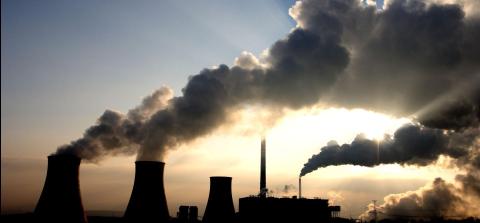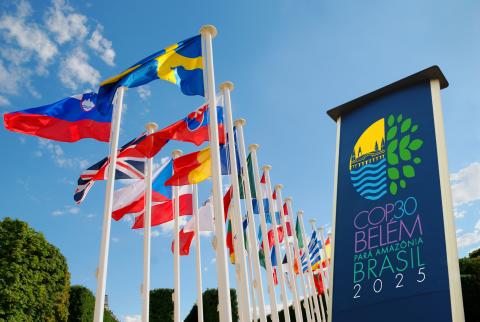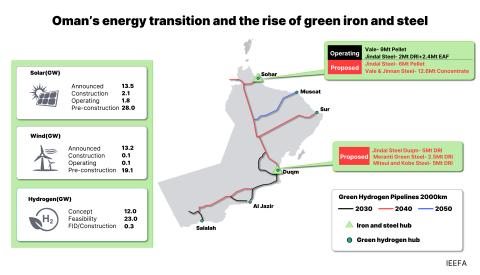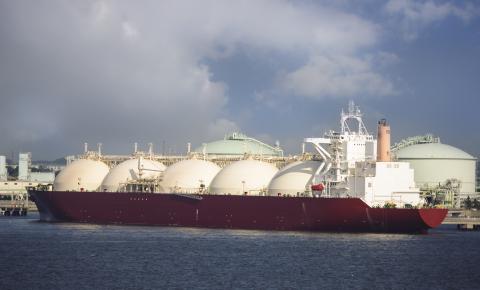China 2017 review: World’s second-biggest economy continues to drive global trends in energy investment
Download Full Report
Key Findings
China began reorganizing its large state-owned power generators in 2017, a move seen as a policy initiative aimed at forcing power companies away from reliance on coal for electricity generation. The building up of domestic clean energy capacity will enable further expansion of Chinese new energy technology overseas.
In November, China Energy Investment Corp. signed a memorandum of understanding with the U.S. state of West Virginia to invest US$84 billion over 20 years in shale gas projects there, highlighting China’s technology-agnostic approach to seeking alternatives to coal.
Domestically, China in all likelihood will have installed at least 50 GW of solar-powered electricity generation in 2017, with Bloomberg New Energy Finance now predicting 54 GW compared to 34.5GW in 2016.
Executive Summary
China continued to be a global leader of investment in clean energy projects in 2017, defying an overall slowdown in Chinese overseas investment as the country further positioned itself to dominate in new energy technologies such as batteries and electric vehicles.
This report documents this trend and follows an IEEFA report published in January of last year —“China’s Global Renewable Energy Expansion”—that highlighted how, in addition to being the world’s largest investor in domestic renewable energy, China was taking the global lead.
A key development since our previous report was the Trump administration’s decision to pull out of the Paris climate agreement, a move that led to China’s quick reaffirmation of its emissions-reduction pledge that allows it to further project itself globally as a responsible major power while addressing its domestic air pollution concerns and building world-leading capacity in new energy markets.
Domestically, China began reorganizing its large state-owned power generators in 2017, a shift seen as an effort to move Chinese power companies away from reliance on coal and to restructure incentives for the largest coal and power companies. August 2017 saw China’s top coal mining company being merged with one of the nation’s “Big Five” power utilities. The combination of China Guodian Corp. and Shenhua Group Corp., now renamed China Energy Investment Corp., created the world’s largest power generator by installed capacity at about 225 gigawatts (GW). The deal also created a company no longer so reliant on coal since Guodian brought significant clean energy assets with it. It also ensures that Shenhua’s growth trajectory will no longer depend on the single-minded pursuit of more coal at the highest possible price—a strategic posture which has burdened China’s power companies and limited their appetite for innovative new clean energy technologies.
2017 was a record-setting year for renewable installation in China while efforts to reduce renewable energy curtailment began to yield results. China is estimated to have installed at least 50 GW of solar-powered generation in 2017, and Bloomberg New Energy Finance now predicts a total of 54 GW—compared to the 34.5 GW it forecast in 2016. Going forward, according to the International Energy Agency (IEA), China will continue to lead the world in renewable energy development.
Internationally, China’s Belt and Road Initiative (BRI) has continued to drive Chinese energy investments overseas. The initiative already has driven US$8 billion of solar equipment exports from China and helped China become the number one exporter of environmental goods and services, overtaking the U.S. and Germany.
The Belt and Road Initiative is technology-agnostic. While international markets provide opportunities for Chinese builders of older technology capacity such as coal and hydropower, Chinese energy investment overseas will follow the global trend toward increased renewable energy capacity. IEA figures show that renewable energy capacity grew by 165 GW in 2016 compared to 55 GW for coal-fired capacity. Given that the IEA sees renewables contributing 60% of global additions to electricity generation capacity over the next five years, it makes sense for China to continue to build on its position as the global leader in renewable energy by looking for opportunities to develop international standard EPC and operating credentials.
The Belt and Road Initiative has defied Chinese curbs on domestic companies making overseas acquisitions. For the first three quarters of 2017, outbound M&A deals by Chinese firms slumped by 35% to US$96 billion due to tightened investment controls intended to restrict capital outflows. However, Chinese M&A activity in countries that are part of the BRI soared in 2017. Through the whole of 2016, Belt and Road-related investments totaled US$31 billion; this figure was surpassed in 2017 by the month of August, and the international accounting firm PwC sees Chinese overseas M&A activity picking up once again in 2018, driven in part by the Belt and Road Initiative.
The initiative was enshrined in the Communist Party constitution in 2017, creating more pressure than ever for it to succeed and confirming China’s desire to expand its role in the global economy.
Among our key findings:
- IEEFA’s identified list of large overseas clean energy projects for 2017 is even greater than the prior year’s list. The total for large projects (valued at US$1 billion or more) in 2017 exceeds US$44 billion (see Figure 1). This compares to US$32 billion identified in 2016, which was itself a record year for Chinese low-emissions-sector investment overseas.
- Chinese solar manufacturers account for about 60% of global solar cell production, and China’s solar manufacturing leadership was cemented in 2017. The first half of 2017 saw an increase in global manufacturing capacity expansion announcements over the second half of 2016. Geographically, the new capacity expansion announcements were more heavily weighted toward China than in 2016. China in 2017 accounted for 70% of planned expansions. Chinese solar module manufacturers continued to feature strongly in overseas solar generation projects. In 2017, Chinese companies took part in projects across Asia, Latin America, Australia, Africa and the Middle East. In the secondary market, they took ownership of solar plants in the U.S.
- Major Chinese wind energy companies, including the world’s largest wind power developer, continued to expand overseas. China Energy Investment Corporation, Xinjiang Goldwind (one of the world’s largest manufacturers of wind turbines), and China Three Gorges (a company historically associated with hydropower) all made major wind power investments in international markets in 2017, buying stakes in operating or expanding wind farms.
- Large Chinese hydropower companies continued to either acquire or to win contracts to build major hydro projects abroad. Latin America, Africa and Asia continued to be areas of focus for Chinese hydro companies even as Belt and Road hydro projects started to face some strong headwinds in Pakistan and Nepal.
- State Grid Corporation, the world’s largest power utility by revenue, leads persistent Chinese international investment in power grids. Having completed the acquisition of a controlling stake in Brazil’s CPFL Energia SA in January 2017, the company announced later in the year that it had increased its holding to 94.75% by way of a US$3.45 billion transaction. State Grid has become the largest power distribution company in Brazil. The company is also involved in Belt and Road Initiative power transmission projects in Pakistan and Egypt, and it is considering further investment in Europe. State Grid continues also to be highly ambitious with various schemes for transcontinental “supergrids”. One such plan that would link China, Japan, Mongolia, Russia and South Korea has the backing of Japan’s Softbank and received support from South Korea’s KEPCO in 2017.
- China is outmaneuvering other economies in securing supplies of new energy commodities. Battery makers and car manufacturers with electric-vehicle (EV) ambitions sought to secure supplies of lithium and nickel in 2017; this trend has also seen Chinese companies maneuver to dominate the cobalt market, with the majority of supply heading back to China. Chinese miners are expected to be responsible for 62% of global supply in 2017, and China also continues to dominate the rare earths mining and processing sector.
- Securing new energy commodities will allow China to dominate battery and EV manufacturing going forward. Bloomberg New Energy Finance sees Chinese companies producing 121 gigawatt-hours (GWh) of battery production capacity by 2020, dwarfing Tesla’s 35 GWh. Chinese battery makers such as Contemporary Amperex Technology Ltd. (CATL) and BYD are key players in this expansion. BYD is already targeting the stationary energy battery storage market in key markets such as the U.S. and Australia. Assisted by government policy, Chinese EV manufacturers are rapidly building domestic capacity. Gaining a strong head start in the electric vehicle sector domestically is a prelude to a push into international markets.
- China is by far the largest market for smart meters globally as the country aggressively seeks significant energy efficiency gains. Chinese investment in energy efficiency showed the strongest growth of any country in 2016, at 24%, and China’s attention to this sector started to move overseas in 2017. In a significant investment, Hong Kong’s Cheung Kong Infrastructure (CKI), a seasoned non-government-linked infrastructure investor, agreed to a US$5.3 billion deal to acquire Germany’s Ista, one of the world’s largest smart metering and energy management companies.
- China’s energy sector has many major financial institutions at its disposal to support its overseas energy ambitions. The China-dominated Asian Infrastructure Investment Bank (AIIB) and the New Development Bank (NDB) are multilateral institutions that are scaling up lending and that in 2017 signaled a preference for clean energy financing over coal investments. China has also set up the Silk Road Fund to directly support its Belt and Road Initiative. China is home, too, to a number of the largest commercial banks in the world and has a range of large “policy banks” with a technology-agnostic view that act as the financial arm of China’s foreign policy. The previous backing of the policy banks for coal projects overseas is set to change going forward as the world turns toward renewables. Other large Chinese financial institutions, including China’s national pension fund, its sovereign wealth fund (China Investment Corporation) and the leading insurance companies also are seeking to diversify their holdings by increasing overseas investments.
Press release: IEEFA: China’s central bank is leading the way with bold green finance policies
Please view full report PDF for references and sources.

















